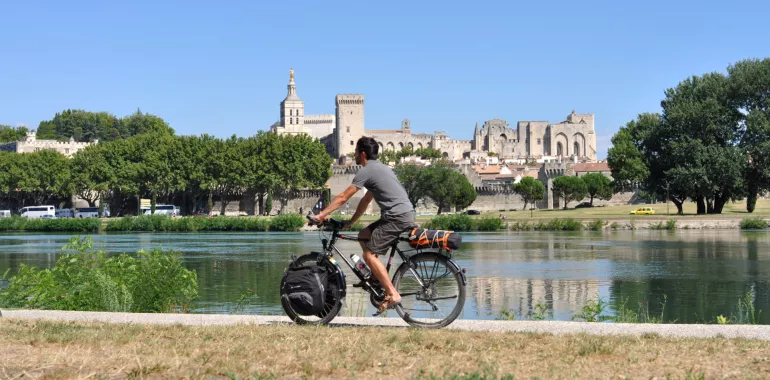Avignon / Beaucaire ViaRhôna
36,47 km cycling route from Avignon to Beaucaire
Elevation of the stage
Waytypes of the stage
Surface of the stage
The route
Leave Avignon via Pont Daladier. Once across this bridge, go straight over the crossroads, then almost immediately after, turn left onto Rue du Chêne Vert, just before the railway bridge (where there are traffic lights). Follow this quiet road, taking you away from the Rhône for a while, before leading you back to the great river after you have passed under the TGV rail bridges at Les Angles. A stretch of greenway leads from the TGV bridges to Aramon. From Aramon to Montfrin, the way is signposted along easy, quiet roads. Next, west of Montfrin, join the Voie Verte du Pont du Gard, a greenway taking you up to the round-about at the entrance to Beaucaire. Here, follow the Chemin de Marguilliers to cycle into the town centre.
Be careful crossing the D2 road to join the greenway.
Railway station (SNCF) :
Avignon train station:
- Line 8 : Marseille > Arles > Tarascon > Avignon
- Line 11 Avignon > Tarascon > Nîmes > Montpellier
- Line 9 : Marseille > Salon > Cavaillon > Avignon
- Line 10 : Marseille > Avignon > Orange > Valence > Lyon
TGV (High-speed rail) :
- Avignon TGV > Paris
- Aix en Provence TGV > Avignon TGV
- Avignon TGV > Marseille Saint-Charles
TER (buses):
- Line 23 : Avignon > Aix-en-Provence
- Line 22 : Avignon > Oraison > Digne
Beaucaire train station
Tarascon train station
Line Narbonne > Montpellier > Avignon
Tourist Information Centres :
- Office de tourisme du Grand Avignon Tél : 04 90 03 70 60
- Office de tourisme d’Avignon Tél : 04 32 74 32 74
- Office de tourisme Destination Pays d'Uzès Pont du Gard Tél : 04 66 22 68 88
- Office de tourisme de Beaucaire Terre d’Argence Tél : 04 66 59 26 57
Don't miss:
Avignon: the historic centre, declared a UNESCO World Heritage Site; the Palais des Papes, the huge palace built for the 14th-century popes based here; fine churches dotted around town; the part-ruined Pont d'Avignon over the Rhône, focus of a famous French song; notable arts museums, such as the Petit Palais, Calvet, Angladon, Vouland and Lambert; the Musée Lapidaire (on archaeology); the Opera House; the Cloître St Louis; the July Festival d’Avignon, French equivalent of the Edinburgh Festival, centred on theatre
Villeneuve Lez Avignon: 14th-century cardinals’ houses known as Livrées cardinalices; the Chartreuse du Val de Bénédiction, a massive charterhouse founded by an Avignon pope, now a cultural centre; the Collégiale Notre-Dame, the central church; the Fort Saint-André and Abbaye Saint-André, set side by side on a hilltop, the latter boasting terraced gardens; the Tour Philippe-le-Bel, built for a powerful 14th-century French king, looking across the Rhône to papal Avignon.
Aramon: the historic centre with its smart houses; the church of St Pancras; the river port.
Beaucaire: the medieval castle perched on its rock above the Rhône; fine townhouses; the underground Abbaye Troglodytique de Saint-Roman et l’Aiguille; the river port; Le Vieux Mas (a traditional working farm between Beaucaire and Saint-Gilles).
Tarascon: the Château du Roi René by the Rhône; the medieval Collégiale Sainte Marthe church; the Cloître des Cordeliers (cloisters); the Abbaye St Michel de Frigolet (5km away)

Travellers’ reviews